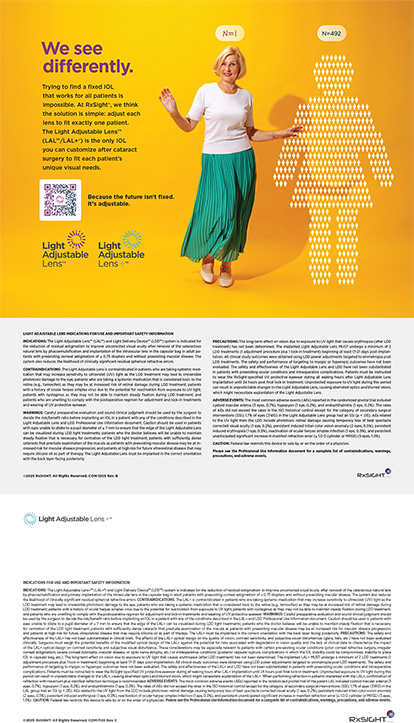A PERSONAL AND PROFESSIONAL COMMITMENT TO SUSTAINABILITY
By Sila Bal, MD, MPH

It is my deep belief that there is no separation between environmental sustainability and every other aspect of our lives, including our role as ophthalmologists. As clinicians and surgeons, we are uniquely positioned to make decisions on behalf of our patients, our practice, and our profession. This intersection facilitates the exchange of innovative solutions and ideas, and eventually, it changes the way we practice medicine.
INTEGRATING SUSTAINABILITY INTO MEDICAL PRACTICE
Every single day, I am in awe that I get to be here, on this planet, surrounded by amazing people, in a profession that I love and that challenges and changes me constantly. These guiding principles are why the adoption of environmentally friendly practices in our field is so important. We ophthalmologists are leaders in our communities. Just as our field continues to challenge and change us as surgeons, it is up to us to challenge and change our profession to better serve and protect our planet.
PRACTICAL STEPS TOWARD REDUCING OUR ENVIRONMENTAL IMPACT
I have been fortunate to have incredible mentors who have given me the space and opportunity to learn from my colleagues and better understand the role of sustainability in ophthalmology. Most sustainability practices, whether in medicine or beyond, focus on the five Rs of sustainability: reduce, reuse, recycle, research, and rethink.
We must focus on reducing waste through reusing, recycling, and donating supplies whenever possible. We need to rethink the way we use consumables because we often have an excess of single-use items that could be sterilized and reused. We must eliminate unnecessary waste, including single-use topical drops.
RESEARCH AND ADVOCACY
Perhaps most importantly, we must develop solutions that are sustainable and easily adoptable. I hope to continue to learn from the incredible innovators in this field and to use that knowledge to advocate for change, both in my own practice and nationally.
WHY I’ll BE JOINING AN ENVIRONMENTALLY FRIENDLY PRACTICE
By Archeta Rajagopalan, BS

As a medical student, I have observed wastefulness in the clinics where I have trained. The impact of climate change is palpable in my own community. The seasons that were distinct in my youth now blur together, marked by deadly heat waves, delayed autumns, and warmer winters. This environmental transformation within my short lifetime raises concerns about the future health of my patients and myself over the coming decades.
HEALTH CARE’S ENVIRONMENTAL IMPACT
The health care industry, which I will soon join, has an impact on the environment. The energy required for health care, derived largely from fossil fuels, accounts for 8.4% of emissions of toxic air pollutants and greenhouse gases in the United States.1 These emissions from health care result in an estimated 405,000 years of life lost annually due to asthma attacks, chronic lung disease, heart attacks, and cancer.1 Furthermore, the climate change driven by greenhouse gases is expected to increase the incidence of heat-related illnesses, mental health issues, and injuries related to extreme weather and wildfires.2
THE GLOBAL PUSH FOR A SUSTAINABLE WORK ENVIRONMENT
Globally, environmental sustainability in the workplace is a priority. In a 2021 IBM survey, two-thirds of respondents said environmental issues were very or extremely important to them personally, with 69% stating they were more likely to work for an organization they perceived as environmentally sustainable.3 Deloitte’s findings echo this sentiment, with 97% of senior managers acknowledging the impact of climate change on their operations and 88% believing their companies should address it.4
Outpatient public health clinics, medical practices, and dental offices are responsible for approximately a quarter of health care’s greenhouse gas emissions.1 I am therefore committed to choosing an environmentally responsible practice for my career, one that prioritizes sustainability and has an established sustainability practice management program. I aspire to collaborate with a team that recognizes the importance of working responsibly.
An informal survey of my medical school peers revealed a shared concern for the environmental impact of our future profession. A fellow student noted the paradox of health care’s environmental footprint amidst medicine’s efforts to protect health. The movement toward greener office spaces is seen as a step toward mitigating the inherent environmental harm of medical practice.
ADVANTAGES OF AND SUPPORT FOR SUSTAINABLE HEALTH CARE
The benefits of adopting green practices in clinical settings are manifold. Besides the potential for cost savings—one multispecialty group saved $1,400 per doctor annually5—such practices can enhance staff satisfaction, patient approval, and community health outcomes. Furthermore, being green can give a practice a competitive advantage in the recruitment of dedicated, community-minded physicians.
Free resources such as EyeSustain and My Green Doctor are available to help health care practices become more sustainable (click here to explore these resources). EyeSustain, backed by a coalition of more than 40 ophthalmology societies, offers resources tailored for ophthalmologists but beneficial to all surgical and procedural disciplines. Similarly, My Green Doctor provides a management program that helps outpatient practices achieve the Green Doctor Office Recognition Certificate.
AN IMPERATIVE STRATEGIC ADVANTAGE
The journey toward environmental sustainability is not only a moral imperative but also a strategic advantage for health care practices. By adopting sustainable practices, we can contribute to a healthier community, enjoy financial savings, and attract the best new talent to the health care field.
1. Sack TL. Green offices are healthier: new analysis. My Green Doctor. January 12, 2024. Accessed January 12, 2024. https://mygreendoctor.org/green-offices-are-healthier-new-analysis/
2. Rocque RJ, Beaudoin C, Ndjaboue R, et al. Health effects of climate change: an overview of systematic reviews. BMJ Open. 2021;11(1):e046333.
3. IBM Institute for Business Value. Sustainability at a turning point: What’s worth more—the present or the future? January 2020. Accessed May 6,2024. https://www.ibm.com/downloads/cas/WLJ7LVP4
4. Deloitte. 2022 Deloitte CxO sustainability report. September 2021. Accessed May 6,2024. https://www.deloitte.com/global/en/issues/climate/deloitte-cxo-sustainability-report.html
5. Success stories: Escambia County Health Department. My Green Doctor. Accessed January 12, 2024. https://mygreendoctor.org/profiles/
SMALL STEPS, SIGNIFICANT IMPACT
By Jenna R. Tauber, MD

As someone who grew up in a Northeastern suburb, I remember the childhood excitement of snow days. A few times each year, my brother and I would leap out of bed and turn on the TV to check if school was canceled. We would grab our sleds and join other kids at the town’s big hill for a day of fun. In grade school, we learned climate change was a looming threat. We tried to do our part by cutting apart plastic soda can holders to protect oceanic species and diligently putting our magazines in the recycling pile at home. I believed that these small steps would protect our planet.
THE STARK REALITY OF ENVIRONMENTAL CHANGE
About 20 years later in that same suburb, we no longer expect snow in the winter. Instead, we brace for torrential rains that cause significant flooding and down trees. I still recycle my magazines, and I am pleased to see that soda cans no longer come packaged with plastic rings—but the reality is stark. The amount of waste produced daily by the health care system makes me feel that my personal efforts are just a drop in the ocean. Over the years, I have come to understand that, although individual efforts are important, they are not enough on their own. Fortunately, I have begun to realize that there are ways for my small actions to have a broader impact.
PROMOTING ACTION
Through research publications and presentations at academic meetings, I try to persuade others within my medical community that eye drops can be reused in the OR or sent home with patients. At work, I point out and praise our sustainable actions and encourage even small changes that can further reduce our carbon footprint safely.
A growing body of research and accessible online resources support these appeals to leadership. I am committed to using and contributing to this body of knowledge to advance efforts to keep our patients safe and protect them from the health dangers of climate change. For now, my focus is on promoting the use of multiuse eye drops, but I hope for opportunities to advocate for more reusable OR equipment, the elimination of paper instructions for use pamphlets, and a reduction in the use of OR drapes.
FACING THE FUTURE WITH DETERMINATION AND HOPE
As a young professional contemplating climate change, I sometimes feel overwhelmed and fearful of what the future may hold. Nothing alleviates my anxiety quite like realizing I have choices and the ability to act. Promoting sustainable practices in ophthalmology addresses two of my greatest concerns: caring for my patients and the planet.
THE EYE AS A MODEL OF EFFICIENCY
By Margaret Tharp, BS

The eye not only fascinates with its complexity but also serves as a prime example of resource efficiency and waste optimization. Its roughly spherical shape provides an optimal ratio of surface area to volume, crucial for protective functions and the selective absorption of light and nutrients—just enough to support the organ’s sophisticated internal mechanisms designed for economical operation and minimal waste.
LEARNING FROM NATURE
There is still much to learn about the eye’s structure and function. Equally important, however, is learning from the eye’s inherent efficiency. How can ophthalmologists emulate this approach of using only what is necessary, utilizing it effectively, and managing residuals responsibly in their daily practice and broader care systems? Understanding and adopting these principles are vital to the sustainability of ophthalmic practice, the well-being of patients, and the health of the planet.
MEANINGFUL CHANGES IN SURGICAL PRACTICES
Because ophthalmology is one of the highest-volume surgical specialties, even seemingly minor changes in clinical and surgical ophthalmic practices, such as reducing unnecessary surgical draping or revising the delivery of topical medications, can have a significant impact when implemented across the specialty. The impact can be magnified if these measures are adopted by other medical fields. Many of these adjustments can be easily integrated with guidance from no-cost, online resources provided by organizations such as EyeSustain and My Green Doctor.
The Aravind Eye Hospitals in India exemplify sustainable practices as standard procedure, offering lessons on efficiency and waste reduction that are applicable to large-scale ophthalmic care systems.
ADVOCACY AND FUTURE DIRECTIONS
Implementing practice-based and policy-driven changes to decrease OR waste and medication use in the United States can reduce health care’s carbon footprint and improve the financial health of hospitals, ambulatory surgical centers, academic institutions, and private practices. With ophthalmology deeply engaged in advocacy at both the state and national levels, the specialty is well positioned to advocate for systemic changes and encourage other medical fields to participate in sustainability efforts.
As a medical student planning to apply to ophthalmology residency programs, I am particularly attracted to those that address sustainability and consider the welfare of both patients and the planet. Although immediate steps toward more sustainable practices in ophthalmology are clear, substantial progress requires collaboration among ophthalmologists at all career stages and across various practice areas.




